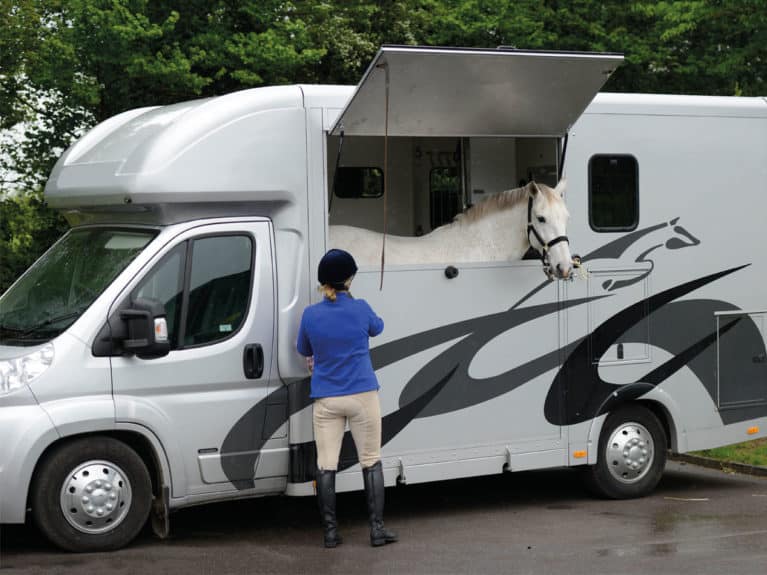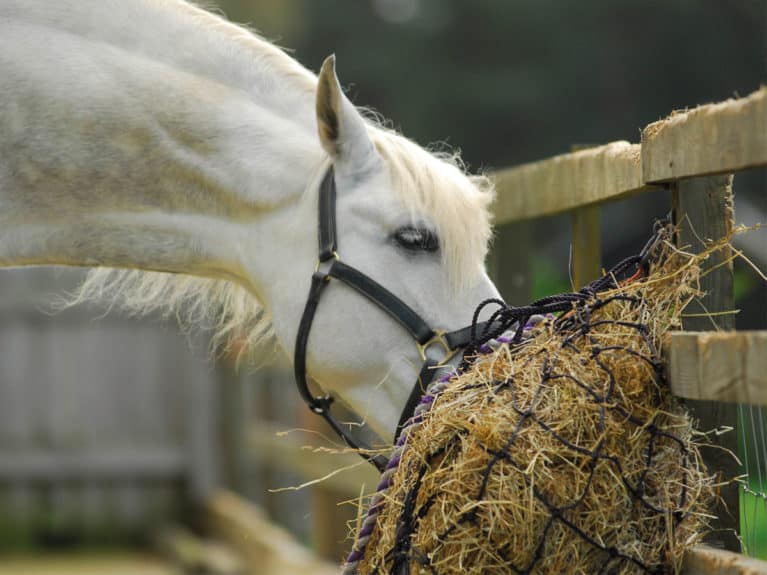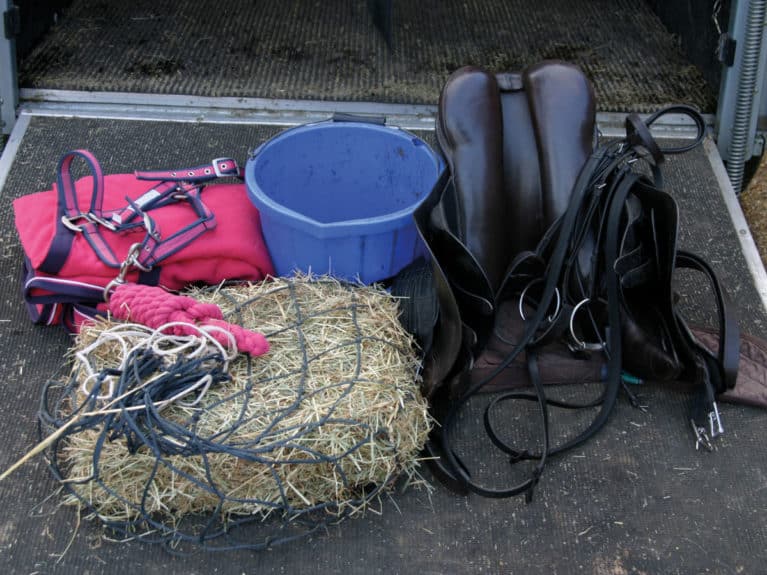Treat your horse to a travel upgrade with advice from top transporters

Week in and week out, scores of the world’s best competition horses are loaded up for long-haul journeys ready to compete in major shows and events. Transporting horses over long distances is no easy feat – in fact, every detail of the journey has to be perfectly planned so the passengers arrive at their destination feeling their very best and ready to perform.
You may never have to prepare your horse for a transcontinental flight or a full day spent on the lorry, but there’s plenty to be learned from the professionals who manage these major moves. We spoke to travel experts to come up with top some insider tips on how to upgrade your horse’s next trip from an economy booking to first-class luxury.
Dressed for success
Sufficient protection is crucial when transporting your horse. If he’s never worn travel boots before, take a gradual approach to introducing them to avoid overwhelming him.
Start with tendon and overreach boots, putting them on in his stable and letting him wear them while he eats his dinner. For safety, supervise him in the first couple of instances before letting him wear them for longer periods. Once he’s happy with tendon boots, you can move onto travel boots, but again, you should take a gradual approach here. Start with one boot at a time, staying with him and letting him get used to the feeling. Take him for a short stroll around the yard and reassure him before adding another boot. You can work up to putting all four boots on over a couple of days, making sure that he’s happy to stand and eat with the boots on, and will also walk quietly alongside you.
A tail bandage and guard combo not only protects the dock from bruising, it also mitigates unsightly rubs and poo stains. Use a damp brush to neaten the top of your horse’s tail, then bandage evenly from the top to the bottom of the bone and back up to about the midway mark. To keep his tail clean in transit, loosely plait the remainder of his tail and tuck the whole lot into a tailguard with a bag.
If you have a tall horse, it’s not a bad idea to attach a padded poll guard to his headcollar to protect him in case he raises his head suddenly. As with travel boots, it’s important to gently acclimatise him to the feeling of the poll guard.
Once the essential areas are protected, it’s best to leave travelling rugs to a minimum to avoid overheating your horse. If you need to keep him clean, or if there’s a chill in the air, throwing a light sheet over him will do the job, but wherever possible, travel him without a rug to allow him to thermoregulate.
Top tip
Travelling your horse in a leather headcollar isn’t just about looking smart – leather breaks away easily in an emergency and can minimise the risk of injury if your horse pulls back. Another option is a safety headcollar with a breakaway tab.
Meals on wheels
Your horse’s digestive system functions at its best when in constant use. Maintaining normal bodily functions and reducing stress are two of the primary aims of conscientious horse transport, so it’s important that he has a constant supply of forage and regular access to water, too.
The nervous passenger
To ensure a smooth, stress-free ride, plan your route with plenty of time to spare, particularly if you’re driving somewhere new. There are several apps available that provide HGV-appropriate sat-nav routes, allowing you to avoid single-track lanes and tight turns where possible. It may be wise to bring a companion while your horse gets used to the idea of life on the road, or, if possible, experiment with different loading options to see which your horse finds most comfortable.
Next stop, services
You might not be travelling to Pau, but there’ll certainly be occasions when you find yourself in the lorry for significant periods of time. If your horse isn’t used to motorway stops, it’s best to avoid them. Instead, plan ahead and see if you can find an equine vet or a transport agent en route, who may well have a quarantined unloading area where you can safely allow your horse to stretch his legs, have a drink and nibble some grass for twenty minutes or so.
Top tip
Using a horsebox camera is a great way to keep an eye on how your horse is travelling and may give you an insight into how to make the journey easier for him.

Travel sickness
Our expert Liz O’Connor is the Director and Transport Manager of LOC International Horse Transport. LOC offers both private and shared loads for domestic and international transport and have travelled thousands of horses far and wide by land, air and sea.
Shipping fever, or travel sickness, is a common term for equine pleuropneumonia, a serious lower respiratory tract infection that can be brought on through extended periods of travel. This disease is most commonly associated with horses travelling abroad, but it can affect horses on domestic journeys, too, especially those who are young, old or vulnerable.
Your horse’s upper respiratory system has an effective filtration system. It contains special cells, designed to trap and reroute debris and bacteria, and mucus, which continually flows upward and back out through his nostrils. This can only work effectively if he’s able to put his head down and allow the mucus to work its way back out, and so the primary cause of travel sickness occurs when the horse’s head remains tied and upright.
Just like pneumonia in humans, travel sickness is a serious condition and if you suspect your horse is suffering, contact your vet immediately.
If you’re planning a long trip, take the following steps to minimise the risk…
- tie his haynet lower than his head This allows for some downward stretch, but also reduces the amount of hay debris and dust he’ll breathe in during his journey
- take and log his temperature Do this before his journey, about an hour after unloading, and then, if he’s considered at-risk, twice a day for a week, as a raised temperature is one of the earliest signs of travel sickness
- don’t plan any strenuous exercise before or after a long journey If you’ve travelled for a competition, leave plenty of time for him to recover, settle and rehydrate first
- plan a rest stop Allow your horse to put his head down, offering a treat from the ground to encourage him to lower his head
Top tip
If you have to give your horse unfamiliar-tasting water sourced at your destination, add sugar-free apple juice to improve its palatability. Try this at home a few times first, otherwise it could put him off.
Hold extra luggage
No matter how long or short a trip you’re undertaking, your lorry or trailer should always hold…
- plenty of water In the unlikely event of an emergency or breakdown, you’ll have far less to worry about if you know your horse won’t become dehydrated
- essential documents This includes your horse’s passport and any veterinary paperwork you need to carry, if you’re going abroad, your horsebox registration and insurance papers, a list of emergency telephone numbers, which should include a next of kin and your horse’s vet, as well as someone who can collect and care for your horse, should the need arise, and the details of your roadside assistance policy
- spare parts Carry an extra headcollar and leadrope alongside an extra set of stirrup leathers and reins to avoid a panic if anything breaks
- well-stocked first aid kits You should have one for your horse and one for any humans on board too, and they should be replenished every time they’re used
- a jerry can and some cash If you run out of fuel the chances are your bankcard will suffice, but it’s always handy to have some cash just in case – or for the burger van
- an extra, small bale of hay or haylage In case you end up staying out longer than anticipated
- a fire extinguisher, jump leads, a warning triangle, a high-vis vest and a tow rope All essential items if you have a breakdown
- spare clothes In the event of a breakdown, your roadside recovery’s priority will be to remove your horse from the situation – but this can mean that you’re left, by the side of the road in the cold, with your empty horsebox for several hours. For this reason, you should also pack…
- plenty of food and drinks to keep yourself going
- an in-vehicle phone charger and a spare powerpack to maintain a working phone
- a rug in case you’re out for longer than planned and the temperature dips
Top tip
Hang a whiteboard in the tack or living area of your trailer or horsebox so that you can keep essential information to hand.

Your Comments
One thought on “On the road again”
Leave a Reply
You must be logged in to post a comment.
















Hi
I wondered if you could help me, I’m looking for some advice on travelling my horse. We moved to Scotland last year and since then he has been a nightmare to travel.
We are based in Fife and have tried various things including travelling him backwards. But he still struggles, especially on right hand turns.
I look forward to your reply.
Kind regards
Sorrel Davies